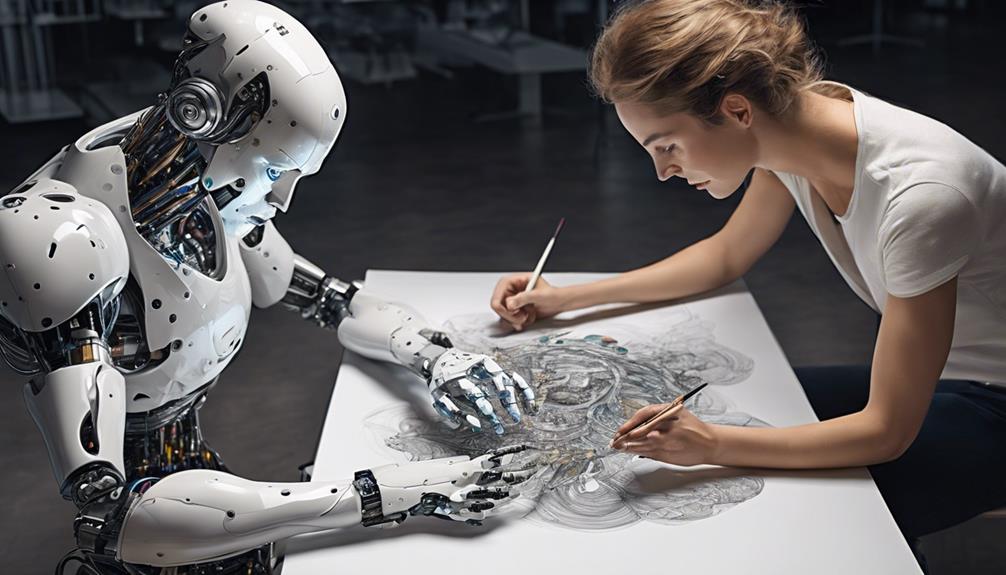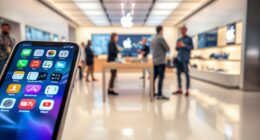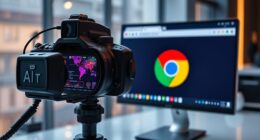The implementation of artificial intelligence (AI) in the art industry has sparked conversations and curiosity in various fields. As AI algorithms play a larger role in the creative process, questions about the role of artists in today’s digital age come to light.
The notion of AI potentially replacing artists poses intricate challenges and opportunities that resonate across artistic, technological, and ethical landscapes. By exploring how AI is reshaping the traditional boundaries of creativity and authorship, one can unravel the complexities and implications of this technological advancement on the future trajectory of art.
Key Takeaways
- AI tools redefine art creation processes by challenging traditional authorship.
- AI fosters global collaborations, diversifying art creation across cultures.
- Ethical concerns arise regarding authorship and authenticity in AI-generated art.
- Collaborative AI platforms like Artbreeder spark community-driven experimentation in digital art.
AI-Powered Art Generation Techniques
Utilizing cutting-edge AI algorithms and tools, the realm of art creation has been dramatically transformed through AI-powered art generation techniques. Artists now have access to advanced technologies such as Generative AI, machine learning, neural networks, and artificial intelligence that enable them to explore new frontiers in creativity. Generative Adversarial Networks (GANs) have emerged as a powerful tool for creating images that closely resemble training or reference images, revolutionizing the way artists approach digital art creation. Image style algorithms have further enhanced the creative process by combining various artistic styles to produce visually stunning effects in AI-generated art pieces.
Moreover, computer-aided drawing tools equipped with AI capabilities offer artists suggestions for colors, textures, and forms, providing valuable assistance in the creation of intricate digital artworks. Image classification systems have also played a crucial role in expanding creative possibilities by generating new images based on specific categories, inspiring artists to push the boundaries of traditional art forms. Additionally, the integration of art chatbots has facilitated collaborative efforts between artists and machines, fostering the development of experimental and innovative art through AI technologies.
Impact of AI on Creativity

The proliferation of AI technologies in the realm of art creation has sparked a profound reevaluation of traditional creative processes, fundamentally altering the landscape of artistic innovation and expression.
- AI tools enable rapid creation and iteration of art, revolutionizing the creative process by providing artists with new means to explore and materialize their visions efficiently.
- AI-generated artworks challenge traditional notions of authorship and authenticity, blurring the lines between human creativity and machine intelligence.
- AI helps overcome linguistic and cultural barriers, fostering diversity in art creation by facilitating cross-cultural collaborations and enabling artists to draw inspiration from a wide range of influences.
- The use of AI in art creation raises questions about creativity and innovation in the industry, prompting discussions on the nature of artistic inspiration and the role of technology in shaping the future of art.
Ethical Concerns in AI Art
AI art presents a complex ethical landscape, fraught with challenges surrounding authorship, authenticity, and the potential ramifications of AI-generated creations. The use of AI in art creation raises significant ethical concerns that need to be addressed. AI artists face dilemmas related to the rightful ownership of their creations, as copyright protection eligibility for AI-generated works varies across different jurisdictions. Moreover, the authenticity of AI-generated art pieces can be questioned, leading to debates about the true artistic value they hold. Deceptive images created by AI further add to the ethical concerns, blurring the lines between reality and artificiality. Additionally, the use of AI tools in art may pose privacy risks and data security issues, as sensitive data might be required for their operation, potentially leading to privacy violations. Ensuring ethical practices in AI art creation is crucial to safeguard artistic diversity and maintain the market value of artworks in an increasingly AI-driven industry.
| Ethical Concerns in AI Art | ||
|---|---|---|
| Authorship | Authenticity | Deceptive Images |
| Privacy Risks | Data Security | Artistic Diversity |
| Market Value |
Collaborative AI Art Tools

Artists navigating the ethical complexities of AI art creation are increasingly turning to collaborative platforms like Artbreeder, where collective creativity thrives through the fusion of human input and artificial intelligence algorithms. Here's a breakdown of the collaborative AI art tools:
- Unique Artworks: Collaborative AI art tools like Artbreeder allow users to combine and manipulate images, resulting in the creation of unique artworks that blend human creativity with AI assistance.
- Collaborative Creative Process: These tools use AI algorithms to suggest variations and adjustments based on user inputs, enabling a dynamic and collaborative creative process where users can build upon each other's ideas.
- Digital Collaboration: With over 300,000 users on Artbreeder collectively generating millions of artworks, these platforms foster digital collaboration, connecting artists and enthusiasts worldwide.
- Artistic Possibilities: Users can fine-tune various parameters such as color, texture, and style on collaborative AI art platforms, opening up a world of artistic possibilities and experimentation in a community-driven environment, enhancing the sense of community among creators.
Future Outlook for AI in Art
Advancements in technology are poised to revolutionize the future of artistic creation by integrating artificial intelligence into the creative process. AI is changing the art world landscape by offering new possibilities for art production. The ability to use AI in generating images has opened up avenues for artists to explore innovative techniques and styles. AI-generated artworks are becoming increasingly prevalent, challenging traditional notions of authorship and creativity. In the future, AI is expected to play a more significant role in the art world, influencing the way art is produced and consumed.
| AI in Art Future Outlook | Description |
|---|---|
| Personalized AI Tools | Tailored AI tools will enhance individual artistic preferences. |
| Human-AI Collaboration | Collaboration between human artists and AI systems will drive innovation. |
| Emergence of New Art Forms | New types of art will challenge traditional artistic boundaries. |
| Experimental Opportunities | AI integration will offer artists unique opportunities for exploration. |
Frequently Asked Questions
How AI Is Revolutionizing the Art World?
AI is transforming the art world by revolutionizing creation, market analysis, and accessibility. Its algorithms generate diverse artworks, inform market trends, and democratize art information. This innovation challenges traditional norms, reshaping how art is both produced and consumed.
Is AI Going to Replace Art?
AI's potential to replace artists raises concerns about the future of creativity. While AI tools enhance efficiency, the debate on whether machines can truly replicate human artistry remains complex. Balancing technological progress with the preservation of artistic authenticity is crucial.
How Has AI Art Evolved?
AI art has evolved by leveraging advanced algorithms like GANs, reducing human intervention in the creation process. This evolution challenges traditional norms, exploring AI's creative potential. Artists such as Mario Klingemann and Jon Rafman embrace AI to produce innovative artworks.
How Is Ai-Generated Art so Good?
AI-generated art excels due to advanced algorithms like GANs that meticulously replicate training data, enabling intricate designs. The fusion of diverse artistic styles and color suggestions enhances visual appeal, while category-based generation fosters creativity and variety.
Conclusion
In conclusion, the integration of AI in art creation has sparked a paradigm shift in the traditional notions of artistic practice.
One compelling example is the collaboration between artist Mario Klingemann and an AI algorithm to create 'Memories of Passersby I,' a mesmerizing piece that challenges the boundaries of human creativity.
As AI continues to revolutionize art, it is crucial for society to critically engage with the ethical implications and possibilities of this innovative technology in shaping the future of artistic expression.









